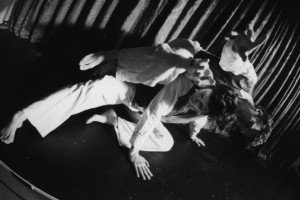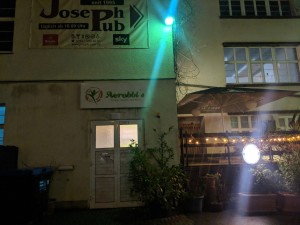Focus Jam / Score Jam, Leipzig
- Facilitated by: Karl Frost

- Dates: 8 January – 26 February 2020
- Time: 19:30 -21:30 on Wednesdays
- Location: Probenraum Tanz Schaubühne Lindenfels
- Karl-Heine-Str 48, 1st floor. (to the right of the main Shaubuhne Lindenfels theater space)
- Cost: 7 – 10 euros drop in
I’ll be hosting a focused jam space on Wednesday nights in January and February. We’ll be using one of two basic formats
- Focus Jam: A short set of warm-up exercises (20-30 minutes) introduces a shared focus or theme from which we then move into an open jam.
- Score Jam: We explore together jamming with a specific score: a set of rules or limitations. The frame allows for the exploration of material that might not arise during an open jam.
The theme for each week can be found on the table below.
Who should come: Everyone is expected to have some experience already in contact improvisation. I am going to be leading and holding space, so everyone coming has to be comfortable also with some amount of direction and shared focus. We aim to hold a convivial, friendly but focused physical practice space as one might find in a contemporary dance or martial arts class.
| Date | Frame |
| 8.1.20 |
Focus Jam: Skin, Fascia, Muscle, Bone Starting exercises will begin with attending to the sensations and mechanics of different anatomical systems. We look at their mechanics, how they change our mental states and imagination as we attend to them, how they interconnect with each other, and how they can serve as part of a vacabulary of physical poetics. After some exercies to introduce the foci, we jam. |
| 15.1.20 | On this date the Probenraum space is not available. There was the thought of an alternate venue and score, but simpler to cancel for the week. We continue on the 22nd as usual. |
| 22.1.20 |
Focus Jam: Mutual listening and following We’ll start with the classic, foundational “Ouija” exercise from CI in the 1970s, with both partners committing to following subtle shifts of pressure and tension at contact leading to an unpredictable flow of mutual following. Then, we jam. |
| 29.1.20 |
Score Jam: Slowness Slowness offers many possibilities for a shift in awareness and a shift in mechanics. As we slow down, we often become a bit more calm. Tai Chi, Alexander technique, Feldenkrais techniue, and Klein release-technique all use slow movement as an opportunity to study how we use our bodies so we can become more functionally aware of our bodies in motion. Certain rituals or circus techniques use slow motion to invite a shift of consciousness or mental state in participants. |
| 5.2.20 |
Focus Jam: Physical Listening, Manipulation, Yielding, Following, Resistance, Agency As we give weight to someone or deliver force, we change the spectrum of possiblities for another’s movement: we manipulate them. The experiment of contact improvisation is a play with mutually affecting each others’ movement. We start with simple physical listening exercises, manipulating a passive partner and lighly following and feeling a moving partner. We play with surrendering into forces, resistance, and redirection. We explore maintaining a sense of agency, including as we actively allow another to move our body or change its trajectory. We take up the agency of affecting someone else’s movement. We stay proprioceptively present with what we together are doing. Hands are available to be used, but we wake up our whole body to this sense of aware mutual manipulation.
|
| 12.2.20 |
Score Jam: Authentic Movement Circle with Active Listening Authentic Movement is an exploration from the late 70s and early 80s, one of a number of practices extrapolating the explorations of Jungian Psychotherapy to the experience of the body. The central practice that emerged out of this body of work is a practice of moving with one’s eyes closed in a state of permission while being watched by a supportive witness and then speaking together about one’s experience moving and one’s experience witnessing. While the initial notion of “authentic” had a particular meaning coming from Jungian work, we will take this in the more open sense, as explored in the more buddhist-informed versions of Authentic Movement that emerged in the late 80s.
|
| 19.2.20 |
Score Jam: The Camera Score We start in stillness with our eyes closed. We imagine that our eyes and ears are a video camera and that we record a film to be shown to someone. We open our eyes and proceed to use our eyes as we might a camera, our ears as we would microphones for audio recording. What kind of film do we create? Is it a documentary? an art film? something else? IS it one continuous film or a series of shorts? It is like being a film maker in a room of filmmakers all filming each other making films. Sort of like a contact jam on psychedelic mushrooms or LSD. |
| 26.2.20 |
Score Jam: Round Robin The “round robin” is the oldest and maybe simplest of contact scores beyond the open jam. We start in a circle. As we are in the circle on the outside, we keep our attention focused on the action in the center, understanding that our supportive attention feeds the dancing in the center. We enter the circle to explore physically, to dance. We might solo. We might join a solo to form a duet. Maybe we cut into an ongoing duet to form a temporary trio. Maybe the trio lasts a while, maybe it is brief. At some point we might leave what we are doing to go out to the side to watch… a temporary trio becomes a duet, a duet disbands… We go in as we like and leave the center as we like, but we try to keep at least one duet in the center at all times and we try to keep at least one person on the outside watching at all times. We try to spend some time witnessing and some time in dancing. We try to let dances “brew” for a bit and develop before cutting in, but at the same time, we understand that it is our obligation at some point to interrupt what is happening to cut in and steal a partner, both to facilitate change and to take over so that some people in the center can take a break to watch. As we dance in the center, we do not try to “entertain”, but instead simply show the results of our experiments in exploration. — We’ll start the Score jam with a bit of open dancing to warm up. Then we’ll move into the Round Robin. |
